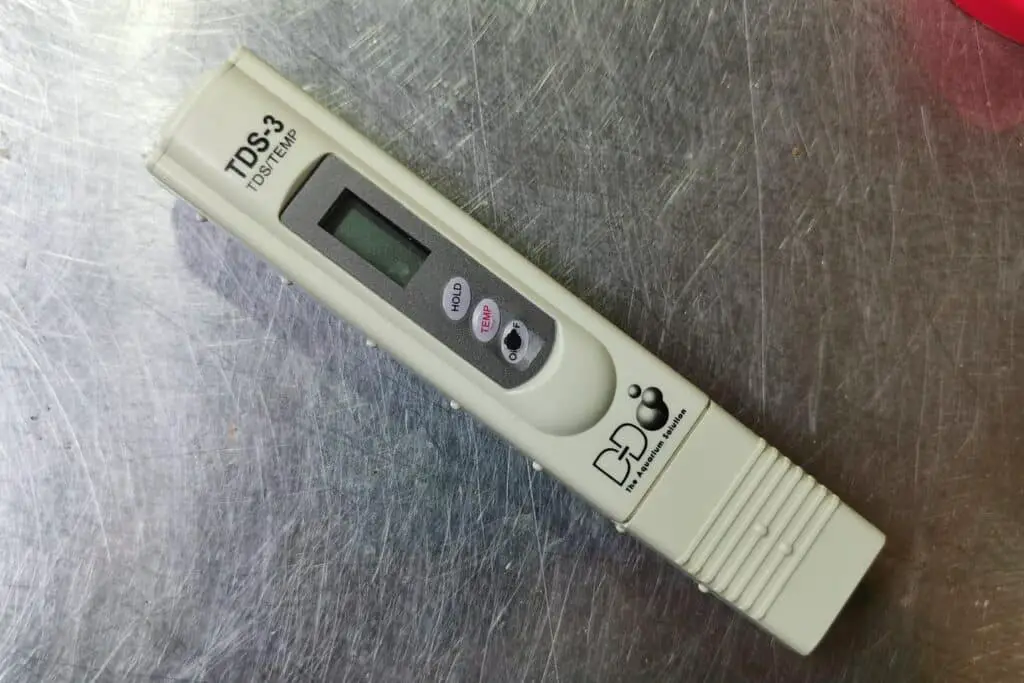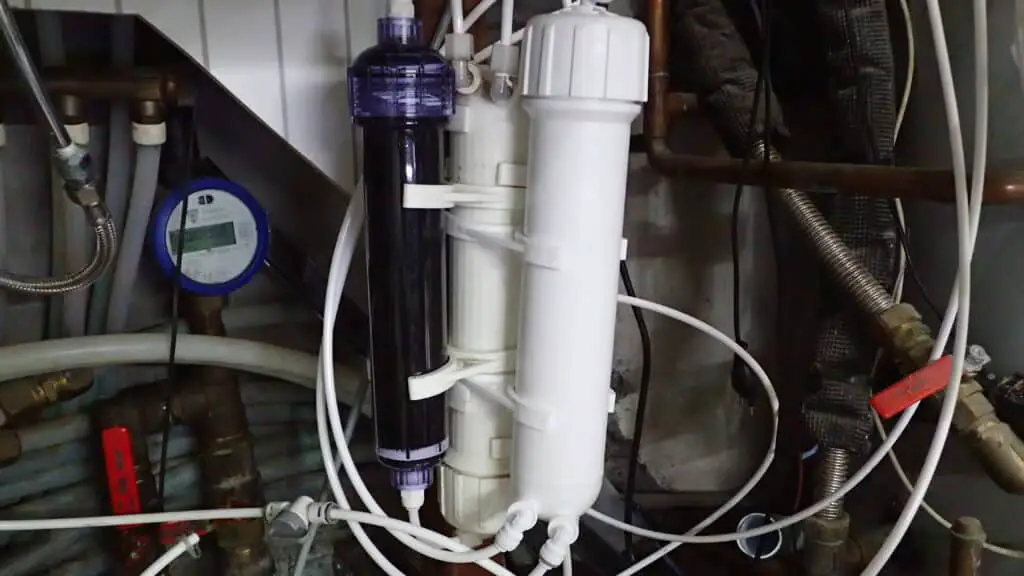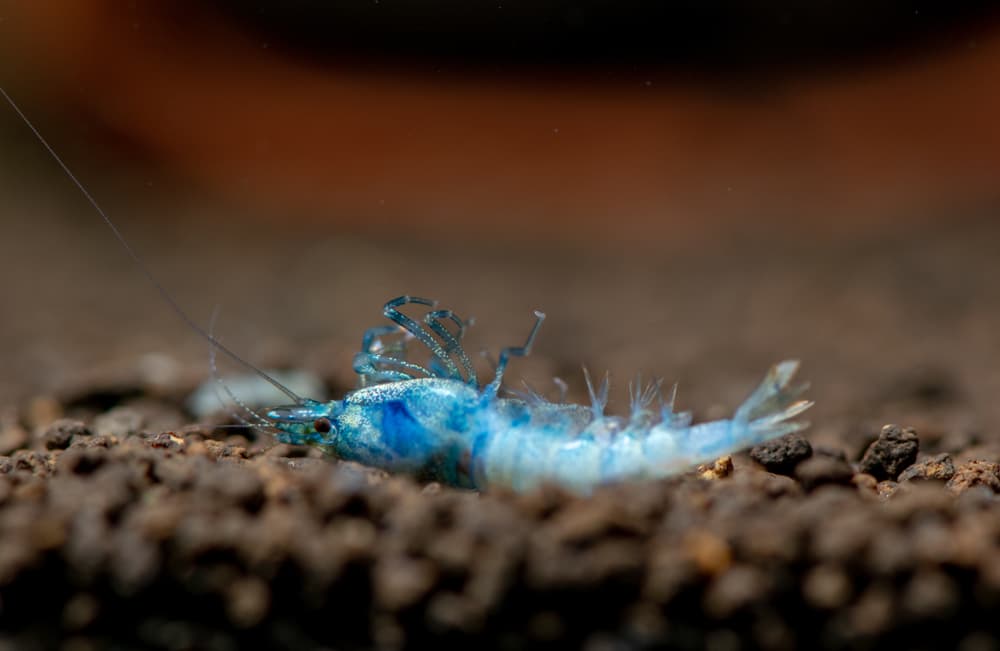Ever found yourself gazing at your shrimp tank, wondering why your little crustacean buddies aren’t as lively as they should be? Or perhaps you’ve noticed a decline in their health and can’t seem to pinpoint the cause. It could very well be due to high Total Dissolved Solids (TDS) in your tank’s water. High TDS can be a silent shrimp killer, but don’t worry, we’ve got your back (and your shrimp’s too)!
The best way to lower TDS in a shrimp tank is through a water change, replacing the old water with pure water such as reverse osmosis water, rainwater, or distilled water. During this process, remember not to add any minerals.
Hello there, fellow shrimp enthusiast! I’ve been in your shoes, staring at my tank, scratching my head, and wondering why my shrimp seemed more interested in lounging around than exploring their aquatic playground. It took me a while to realize that the invisible culprit was high TDS levels.
Over the years, I’ve faced some challenges in maintaining the perfect TDS balance. Sometimes I’d do a water change, only to find the TDS levels spiking again. It was like a never-ending game of ‘whack-a-mole’. I tried different methods, from using tap water (not the best idea, I learned) to experimenting with various types of pure water.
(not the best idea, I learned) to experimenting with various types of pure water.
So, buckle up and get ready to dive into the world of TDS management in shrimp tanks. It’s a journey, but with a bit of patience and the proper knowledge, you’ll be a TDS-tackling champion in no time!
(H2) Disclaimer: The Role of TDS Measurement in Shrimp Keeping
While TDS measurement can be a useful tool in shrimp keeping, it’s important to understand its limitations and proper usage. TDS measurement should primarily be used in conjunction with reverse osmosis water and when you need to use a buffer.
water and when you need to use a buffer.
In most other situations, it’s typically more beneficial to measure your General Hardness (GH) and Carbonate Hardness (KH) to get a better understanding of what’s happening in your tank. These parameters provide more specific information about the mineral
(GH) and Carbonate Hardness (KH) to get a better understanding of what’s happening in your tank. These parameters provide more specific information about the mineral content of your water, which directly impacts your shrimp’s health.
content of your water, which directly impacts your shrimp’s health.
Remember, TDS is a broad measure that includes all organic and inorganic substances in your water. It doesn’t distinguish between beneficial minerals and potentially harmful substances. Therefore, relying solely on TDS measurements without considering GH and KH can give you an incomplete picture of your water quality.
In the end, successful shrimp keeping is about understanding and managing all aspects of your tank’s environment. So, use TDS measurements as one tool in your toolkit, but don’t forget about the importance of GH and KH.

How does TDS affect shrimp health?
Total Dissolved Solids (TDS) is a measure of all the organic and inorganic substances dissolved in your tank’s water. This includes everything from minerals and salts to tiny particles of organic matter.
You might be thinking, “Well, that doesn’t sound too bad. Minerals are good, right?” And you’d be correct, to an extent. Shrimp do need certain minerals to thrive. However, like most things in life, it’s all about balance.
When TDS levels are too high, it can cause a host of problems for your shrimp. For starters, it can lead to osmotic stress. Shrimp regulate their internal salinity to match their environment. When the TDS is too high, they have to work overtime to maintain this balance, leading to stress and health issues over time.
High TDS can also indicate the presence of harmful substances in the water. For instance, high levels of heavy metals, ammonia, or nitrate can harm shrimp’s health. These substances can cause everything from poor molting to decreased activity and in severe cases, can even be fatal.
can harm shrimp’s health. These substances can cause everything from poor molting to decreased activity and in severe cases, can even be fatal.
On the flip side, if TDS levels are too low, your shrimp may not get the essential minerals they need for growth and molting. This can lead to weak shells and stunted growth. So, as a shrimp keeper, it’s crucial to strike the right balance, ensuring your water isn’t too pure nor too polluted. It’s a bit like Goldilocks and her porridge – you want the TDS levels to be just right.

What types of water are best for lowering TDS in a shrimp tank?
When it comes to lowering TDS in a shrimp tank, the type of water you use can make a world of difference. Now, you might be tempted to reach for that tap, but hold your horses – or your shrimp! Tap water often contains minerals and other substances that can increase TDS levels, so it’s not always the best choice.
often contains minerals and other substances that can increase TDS levels, so it’s not always the best choice.
Instead, consider using pure water types such as reverse osmosis water, rainwater, or distilled water. These types of water have undergone processes to remove most, if not all, of their mineral content, making them excellent for lowering TDS levels.
Reverse osmosis water, or RO water, is created using a filtration process that removes up to 99% of dissolved solids. It’s like deep cleaning your water, leaving it fresh and pure. Rainwater, if collected properly, can also be a good option as it’s naturally soft and free of many common contaminants. However, be aware of potential pollutants, especially if you live in a city with high air pollution.
Distilled water is another option. It’s created by boiling water and then condensing the steam, leaving behind most impurities.

How often should you change the water to maintain optimal TDS levels?
Maintaining optimal TDS levels in your shrimp tank is a bit like keeping a well-tuned orchestra playing in harmony. It requires regular attention and fine-tuning. One of the key ways to do this is through water changes. But how often should you be changing the water? Well, that’s a bit like asking how long is a piece of string – it depends on several factors.
– it depends on several factors.
Generally, a good rule of thumb is to perform a water change of about 10-20% of your tank’s volume every week. This helps to keep TDS levels stable and prevent them from creeping up too high. However, this can vary depending on your tank’s size, the number of shrimp you have, and the quality of your water.
If you notice that your TDS levels are consistently high, even after water changes, you might need to change the water more frequently or in larger amounts. On the other hand, if your TDS levels are stable and your shrimp are happy and healthy, you might be able to get away with less frequent changes.
Remember, it’s not just about changing the water, but also about what you’re changing it with. Using pure water types like reverse osmosis water, rainwater, or distilled water can help to lower TDS levels.

What are the signs of high TDS in a shrimp tank?
Detecting high TDS in a shrimp tank can be a bit like playing detective. The clues are often subtle and require a keen eye to spot. But don’t worry, you don’t need a magnifying glass or a deerstalker hat – just a bit of knowledge and observation.
One of the first signs of high TDS is a change in your shrimp’s behavior. Shrimp are lively little creatures, always on the move, exploring their environment. If you notice your shrimp becoming lethargic or less active than usual, it could be a sign that the TDS levels are too high.
Another sign is difficulty during molting. Shrimp shed their exoskeletons regularly, a process known as molting. High TDS levels can interfere with this process, leading to incomplete or difficult molts. If you notice molted shells with missing parts or shrimp struggling to shed their old shells, it might be time to check your TDS levels.
In severe cases, high TDS can lead to health issues and even death. If you notice your shrimp’s health declining without any other apparent cause, high TDS could be the culprit.
Remember, these signs are not definitive proof of high TDS. They could be caused by other issues in your tank. The best way to know for sure is to test your water regularly with a TDS meter. It’s a bit like having your own shrimp health detective kit. With regular testing and observation, you can ensure your shrimp tank is a safe and healthy environment for your little crustacean buddies.
In a Nutshell: Tackling TDS in Your Shrimp Tank

Managing Total Dissolved Solids (TDS) in your shrimp tank is a crucial aspect of shrimp keeping. High TDS levels can lead to stress and health issues in your shrimp, while low levels can deprive them of essential minerals. The key is to strike a balance, ensuring your water isn’t too pure nor too polluted.
Regular water changes using pure water types like reverse osmosis water, rainwater, or distilled water can help maintain optimal TDS levels. But remember, it’s not just about changing the water, but also about what you’re changing it with. Don’t forget to remineralize to provide your shrimp with the essential nutrients they need.
Keep a keen eye on your shrimp and their behavior. Changes in activity levels or difficulties during molting can be signs of high TDS. Regular testing with a TDS meter can help you stay on top of things and ensure your shrimp tank is a safe and healthy environment.
Lastly, remember that every shrimp tank is unique, and what works for one might not work for another. Don’t be afraid to experiment and find what works best for you and your shrimp. After all, shrimp keeping is as much an art as it is a science.
If you need any help or have any questions, don’t hesitate to reach out. If you can’t reach me here, check out the aquarium shrimp keeping groups on Facebook. There’s a whole community of shrimp enthusiasts out there ready to lend a hand.
On a final note, remember to enjoy the journey. Shrimp keeping is a rewarding hobby that brings a little piece of nature into your home. So, here’s to clear waters, happy shrimp, and perfect TDS levels.
Happy Shrimp Keeping!

FAQ: Tackling TDS in Your Shrimp Tank
Q. What is the ideal TDS for shrimp?
A. There isn’t a one-size-fits-all answer to this as the ideal TDS can vary depending on the type of shrimp. However, most freshwater shrimp thrive in water with a TDS level of around 150-250 ppm. It’s always a good idea to research the specific needs of your shrimp species.
Q. What does TDS mean in shrimp?
A. TDS stands for Total Dissolved Solids. It’s a measure of all the organic and inorganic substances dissolved in your tank’s water. This includes minerals, salts, and tiny particles of organic matter. In the context of shrimp, TDS is important as it can impact their health and well-being.
Q. What is a safe TDS level for aquarium?
A. A safe TDS level for an aquarium largely depends on the inhabitants of the tank. For most freshwater shrimp, a TDS level of around 150-250 ppm is considered safe. However, some species may prefer softer or harder water. Regular testing and monitoring are key to maintaining safe TDS levels.
Q. What is the TDS of Neocaridina Davidi?
A. Neocaridina Davidi, commonly known as Cherry Shrimp, generally thrive in water with a TDS level of around 150-250 ppm. However, they are known for their adaptability and can tolerate a wider range of conditions.
Q. How to change TDS in a shrimp tank?
A. The most effective way to change TDS in a shrimp tank is through water changes. Replacing a portion of the tank water with pure water types like reverse osmosis water, rainwater, or distilled water can help lower TDS levels. Remember to remineralize the water to provide your shrimp with the essential minerals they need.
